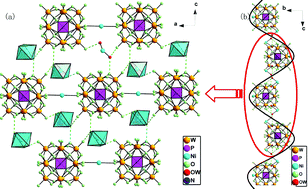Three supramolecular architectures based on α-Keggin-type polyoxometalates have been synthesized hydrothermally, and their structures have been characterized by elemental analyses, infrared (IR) spectroscopy, X-ray photoelectron spectroscopy (XPS) and single crystal X-ray diffraction structure analyses. [Ni(enMe)2(H2O)2]2[Ni(enMe)2PWVI9WV3O40]·H2O (1) (enMe = 1,2′-propanediamine) exhibits a novel 2-D supramolecular sinusoidal layer through the interactions between transition metal complexes and 1-D covalent chains which are constructed from α-Keggin units bridged by transition metal complexes. [Ni(enMe)2]4{[Ni(enMe)2][Ni(enMe)2(H2O)AsWVI6WV4VIV4O42]2}·6H2O (2), representing a 3-D supramolecular framework with 1-D channels, contains the first example of a tungstate dimer with inorganic–organic composite surfaces built up from [Ni(enMe)2]2+ cation bridges and bi-capped α-Keggin polyoxometalate building blocks supporting the transition metal complex. [Ni(enMe)2]4{[Ni(enMe)2][Ni(enMe)2(H2O)AsMoVI4MoV4VIV8O44]2}·8H2O (3), showing a 3-D supramolecular framework with 1-D channels, contains the first example of a molybdoarsenate dimer formed by [Ni(enMe)2]2+ cations bridging two neighboring tetra-capped α-Keggin-based molybdates that support the transition metal complex [Ni(enMe)2H2O]. The topological networks of the supramolecular frameworks of 2 and 3 are analogous. Crystal structural analysis reveals that the dimensionality and the organization of polyoxometalate building units in the solid state can be tuned by the steric hindrances of the polyanions. Both 2 and 3 exhibit intensive photoluminescence.

You have access to this article
 Please wait while we load your content...
Something went wrong. Try again?
Please wait while we load your content...
Something went wrong. Try again?


 Please wait while we load your content...
Please wait while we load your content...